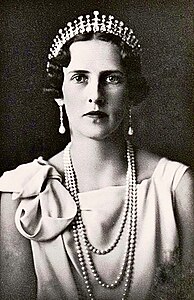Irene af Grækenland (1904-1974)
| Irene af Grækenland | |
|---|---|
 | |
| Personlig information | |
| Født | 13. februar 1904 Athen, Grækenland |
| Død | 15. april 1974 (70 år) Fiesole, Italien |
| Dødsårsag | Læbe og oral hulrum carcinoma |
| Gravsted | Basilica di Superga |
| Far | Konstantin 1. af Grækenland |
| Mor | Sophie af Preussen |
| Søskende | Alexander af Grækenland, Georg 2. af Grækenland, Paul af Grækenland, Helena af Grækenland, Katharina af Grækenland |
| Ægtefælle | Aimone af Savoyen.Aosta (1939-1948) |
| Barn | Amedeo af Savoyen-Aosta |
| Uddannelse og virke | |
| Beskæftigelse | Sygeplejerske, gemalinde |
| Signatur | |
| Information med symbolet | |
Prinsesse Irene af Grækenland og Danmark (græsk: Πριγκίπισσα Ειρήνη της Ελλάδας και Δανίας) (født 13. februar 1904, død 15. april 1974), var en græsk prinsesse, der var hertuginde af Aosta og titulær dronning af Kroatien fra 1941 til 1943.
Forældre
Prinsesse Irene blev født den 13. februar 1904 i Grækenlands hovedstad Athen som det femte barn og den anden datter af Konstantin 1. af Grækenland og Sophie af Preussen.
Ægteskab og barn
I 1927 blev hun forlovet med sin halvfætter Prins Christian af Schaumburg-Lippe, søn af Prins Frederik af Schaumburg-Lippe og Prinsesse Louise af Danmark.[1] Ægteskabsplanerne blev dog aldrig til noget, og Prins Christian giftede sig senere med sin kusine Prinsesse Feodora af Danmark.
I 1939 giftede prinsesse Irene sig med den italienske prins Aimone af Savoyen-Aosta. Han blev senere den fjerde hertug af Aosta. I en kort periode var hendes mand titulær konge af Kroatien (Tomislav 2. af Kroatien). Deres eneste barn var sønnen prins Amedeo, der blev født i 1943. Han blev senere den femte titulære hertug af Aosta efter sin fars død i 1948.
Referencer
- ^ "Princess Irene of Greece Tells Engagement To Prince Christian of Schaumburg-Lippe". The New York Times. 13. oktober 1927. Hentet 26. februar 2010.
Litteratur
- Beéche, Arturo E.; Greece, Michael of; Hemis-Markesinis, Helen (2007). The Royal Hellenic dynasty (engelsk). Eurohistory. ISBN 0-9771961-5-1.
- Bramsen, Bo (1992). Huset Glücksborg. Europas svigerfader og hans efterslægt (2. udgave). København: Forum. ISBN 87-553-1843-6.
| Spire |
| Spire Denne artikel om en kongelig eller fyrstelig person er en spire som bør udbygges. Du er velkommen til at hjælpe Wikipedia ved at udvide den. |
Medier brugt på denne side
Signature of Princess Irene of Greece and Denmark Duchess of Aosta
Princess Irene, Duchess of Aosta
Coat of arms of the Kingdom of Greece in 1936–1973
- Royal Coat of Arms of Greece under the Glücksburg dynasty, created after the restoration of King George II to the throne in 1935, to the exile of King Constantine II in 1967 and finally until the abolition of the monarchy in 1973.
- The Escutcheon features the white cross on a dark blue field of Greece. The Inescutcheon features the Arms of the Greek line of the House of Schleswig-Holstein-Sonderburg-Glücksburg. The shield is then topped with a golden Royal Crown.
- It features an escutcheon divided by the red and white cross of the Order of the Danneborg, the first quarter features the arms of Denmark (three crowned blue lions and nine hearts in yellow field). The second of Schleswig (two blue lions passant in yellow field). The third divided into four; the chief features the three royal crowns in blue field of the Kalmar Union, the second half with a crowned stockfish on red field of Iceland and the last half divided between the ram of the Faroe Islands and a polar bear of Greenland, both on blue fields. The fourth quarter is divided between two halves, the chief depicts a yellow field with a blue lion passant over nine red hearts of the King of the Goths, the lower half depicts a crowned golden lindorm on a red field of the King of the Wends.
- Upon it is another inescutcheon in red, divided into four quarters: the first a a silver nettle leaf of Holstein, the second the a swan with a golden crown of Stormarn, the third a knight dressed in golden armor on a silver horse of Dithmarschen and the fourth of a golden horse's head of Lauenburg.
- Upon it is another inescutcheon divided the first features the red and yellow bars of Oldenburg, the second a golden cross on a blue field of Delmenhorst.
- The escutcheon rests on a golden pedestal and supported by two human figures representing the Greek mythological hero Herakles (Heracles), holding a wooden club and wearing the skin of the Nemean lion.
- The escutcheon is surrounded by the ribbon and cross of the Order of the Redeemer, the cross depicts Christ Pantocrator, surrounded by the order's motto:"Η ΔΕΞΙΑ ΣΟΥ ΧΕΙΡ, ΚΥΡΙΕ, ΔΕΔΟΞΑΣΤΑΙ ΕΝ ΙΣΧΥΙ" or "Thy right hand, O Lord, is become glorious in power" from Exodus, 15:6.
- The motto of the Coat of arms and of the dynasty, depicted on a golden ribbon below the pedestal reads: "Ἰσχύς μου ἡ ἀγάπη τοῦ λαοῦ" or "The people's love, my strength"
- The coat of arms is then surrounded by a dark blue mantle and topped with another royal crown.







